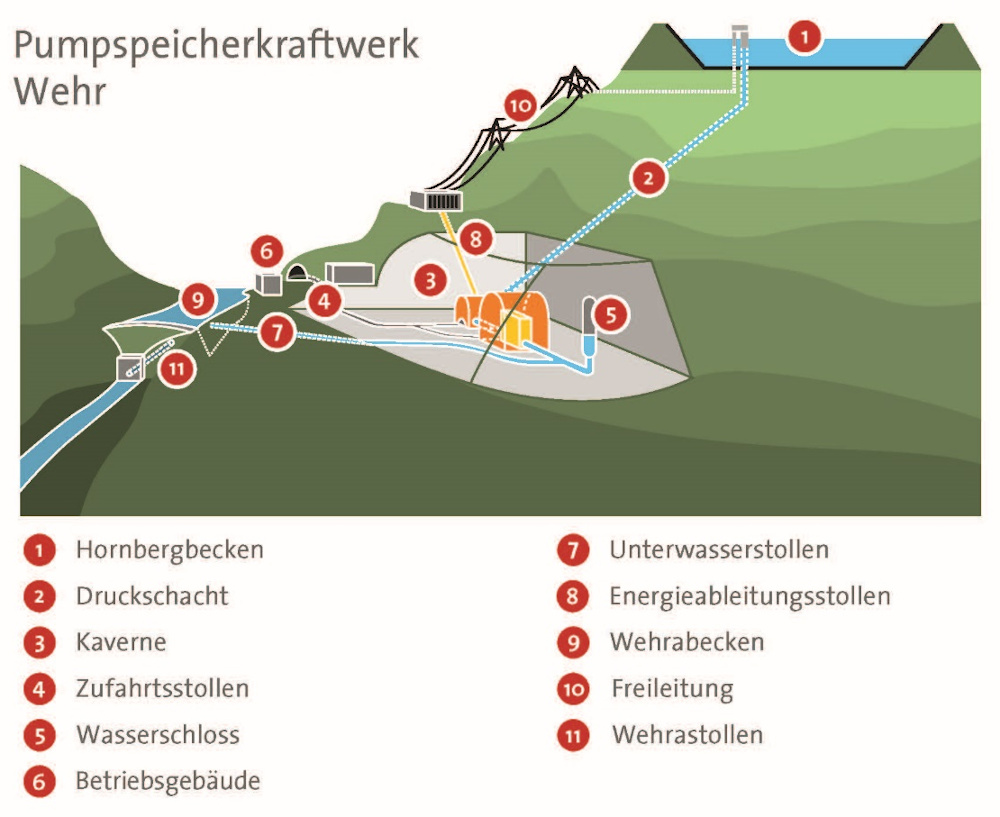Wehr underground hydropower plant - Energy deep within the mountain
Wehr pumped-storage power plant is the most powerful of its kind in Germany. The four hydroelectric sets generate around one billion kilowatt-hours of power annually.
In a process not dependent on the weather, state-of-the-art technology moves huge masses of water in a closed circuit between Wehra reservoir and Hornberg reservoir, which lies roughly 600 metres higher up. From there, the water passes along a steel-plated pressure shaft 1,385 meters long and 5.5 meters in diameter to the machine hall within the cavern, where it drives huge turbines, making it possible to generate electricity within a matter of seconds if required.
In a reverse process, high-power pumps are used here to pump water from Wehra reservoir up to Hornberg reservoir to relieve the pressure on the power grid, depending on what the power grids need at the time.
One key feature is the additional and independent machine with black-start capability, which, with its output of around four megawatts, can be the starting point for restoring the system following a power grid collapse in Germany.
Energy transition
Being able to store electricity in large quantities and generate it within seconds when needed is now more important than ever. The sun and the wind have long been playing their part in generating electricity in Germany and are producing an ever increasing share. Yet these generation sources fluctuate depending on the weather and are unreliable. Pumped-storage power plants come into play when too much electricity overloads the grid or a lack of electricity threatens the supply. They work within seconds, produce zero emissions and generate outputs that rank them among the best of all available storage technologies.
How pumped-storage power plants work
Pumped-storage plants consist of an upper and lower basin. Between them are power plants, which pump water uphill if there is excess electricity and allow it to flow down again through turbines to generate electricity when power is needed. They are precisely tailored to meet the needs of the grid at all times. As such, they help to secure the supply – cleanly, effectively and reliably.
Schluchseewerk AG
With its five pumped-storage power plants, Schluchseewerk AG is one of Germany’s largest suppliers and leading experts. As a partner to its shareholders, it oversees the safe and reliable operation of all its facilities, thereby helping to stabilise the power grid and playing its part in safeguarding the energy supply for today and tomorrow. Schluchseewerk – we are driven by water!
Technical data:
| . | . |
|---|---|
| Construction period | 1968 to 1976 |
| Underwater tunnel | 1,502 metres long with a diameter of 7 metres |
| Average drop height in metres | 625 |
| Generator output in megawatts (average): | 910 |
| Pump output in megawatts (average): | 980 |
| Upper reservoir | Hornberg reservoir |
| Lower reservoir | Wehra reservoir |
Facts and figures
- Cavern: 219 metres long, 19 metres wide and 35 metres high
- Wehra reservoir capacity: 4.3 million cubic metres of water; Hornberg reservoir: 4.4 million cubic metres of water (enough to generate power at full load for around seven hours)
- Maximum turbine flow rate: 180 cubic metres of water per second
- Maximum pump flow rate: 144 cubic metres of water per second
| DE | EN |
|---|---|
| Pumpspeicherkraftwerk Wehr | Wehr pumped-storage power plant |
| Hornbergbecken | Hornberg reservoir |
| Druckschacht | Pressure shaft |
| Kaverne | Cavern |
| Zufahrtsstollen | Access tunnel |
| Wasserschloss | Surge tank |
| Betriebsgebäude | Plant building |
| Unterwasserstollen | Underwater tunnel |
| Energieableitungsstollen | Energy diversion tunnel |
| Wehrabecken | Wehra reservoir |
| Freileitung | Overhead lines |
| Wehrastollen | Wehra tunnel |







